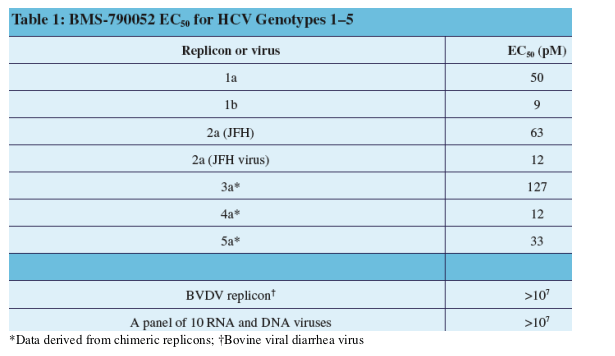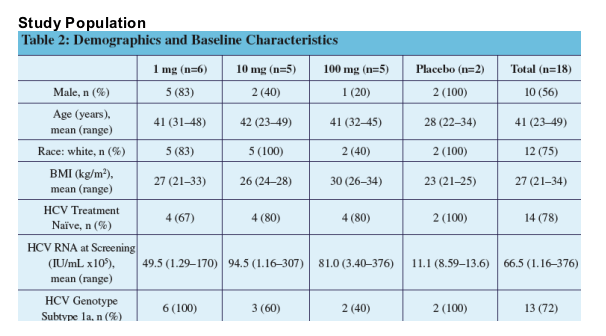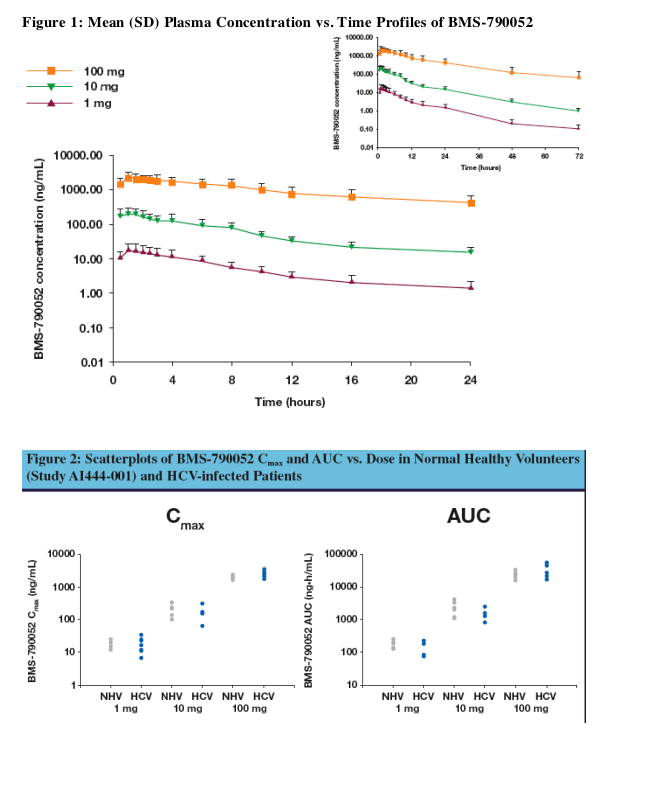 |
 |
 |
| |
BMS-790052 is a First-in-class Potent Hepatitis C Virus (HCV) NS5A Inhibitor for Patients with Chronic HCV Infection: Results from a Proof-of-concept Study
|
| |
| |
Reported by Jules Levin
AASLD Nov 3 2008, San Francisco, CA
This morning was the Late Breaker HCV new drugs poster session, where new data for several new drugs were presented. This new class of drug, the BMS NS5A inhibitor, attracted quite a lot of discussion because of it potent viral load reduction of -3.6 logs, after one dose in 48 hours. This is the first data publicly reported and obviously it is very early. Also presented was the Tibotec protease inhibitor TMC435, the new Pfizer NNRTI, Roche/Pharmasset's R7128, Anadys' NNRTI, Schering's HCV protease inhibitor boceprevir data, and a few others. The Pfizer drug and the Tibotec drug looked potent and promising. Merck wil be presenting this afternoon early patient data from their HCV protease inhibitor. And tomorrow Vertex's telaprevir data, Boerhinger Ingleheim's protease inhibitor, and several others interesting and promising new drug data will be reported.
AUTHOR CONCLUSIONS
BMS-790052 is a potent NS5A inhibitor that:
- was safe and well tolerated in single doses up to 100 mg
- has a PK profile that potentially supports once-daily dosing
- produced a robust decline in HCV RNA (-3.6 logs after 48 hours from a single 100 mg) dosefollowing a single dose in patients chronically infected with HCV genotype 1
Multiple ascending dose trials are ongoing
Richard E Nettles1, Caly Chien1, Ellen Chung1, Anna Persson1, Min Gao1, Makonen Belema1, Nicholas Meanwell1, Michael DeMicco2, Thomas Marbury3, Ronald Goldwater4, Patrick G Northup5,
John Coumbis1, Walter K Kraft6, Michael Charlton7, Juan Carlos Lopez-Talavera1, Dennis M Grasela1
1Bristol-Myers Squibb, Research and Development, Princeton, NJ; 2Advanced Clinical Research Institute, Anaheim, CA; 3Orlando Clinical Research Center, Orlando, FL; 4PAREXEL International, Baltimore, MD;
5University of Virginia, Charlottesville, VA; 6Thomas Jefferson University, Philadelphia, PA; 7Mayo Clinic, Rochester, MN
BACKGROUND
NS5A is an essential component of the hepatitis C virus (HCV) replication complex
BMS-790052 is a first-in-class, highly selective, oral HCV NS5A inhibitor
BMS-790052 has broad genotype coverage and exhibits picomolar in vitro
potency against genotypes 1a and 1b

BMS-790052 has additive to synergistic effects in combination with interferon
and other HCV inhibitors in vitro
In a single ascending dose study in healthy non-HCV infected patients
(Protocol AI444-001), BMS-790052:
- was safe and well tolerated
- had a pharmacokinetic (PK) profile suggesting the possibility of once-daily dosing
METHODS
Study Design
⋅ Double-blind, placebo-controlled, single ascending dose study
⋅ Patients were randomized to receive 1, 10 or 100 mg of BMS-790052 or placebo
- Six patients per dose (active:placebo=5:1)
⋅ Enrollment criteria
- Male or female
- 18 to 49 years of age
- HCV genotype 1
- Treatment naïve or experienced
- Body mass index (BMI) of 18-35 kg/m2
- HCV RNA ≥105 IU/mL at screening
- Documented FibroTestTM score of ≦0.59 and AST to platelet ratio index (APRI) ≦2
-- Non-cirrhotic compensated liver disease
Study Objectives
Primary
- To assess the safety and tolerability of a single oral dose of 1, 10 and 100 mg of BMS-790052 in patients with chronic genotype 1 HCV infection
Secondary
- To assess the single-dose PK of BMS-790052
- To assess the effect of a single dose of BMS-790052 on plasma HCV RNA dynamics
Study Assessments
⋅ Safety and tolerability
- Assessed by physical examination, vital sign measurements, ECGs, clinical laboratory tests and adverse event (AE) reporting
⋅ Bioanalytical methods
- LC/MS/MS (tandem mass spectrometry)
- LLOQ=0.05 ng/mL for BMS-790052
- QC deviations within +/- 15% for BMS-790052
⋅ PK analysis
- PK parameters were calculated by non-compartmental analysis using Kinetica
⋅ HCV RNA was measured with the Roche COBAS® TaqMan® HCV Test, v2.0
- LLOQ=25 IU/mL
⋅ Statistical analysis
- PK parameters and changes in HCV RNA from baseline (in log10 IU/mL) were calculated and summarized by dose (baseline HCV RNA defined as log10 IU/mL prior to dosing)
RESULTS

⋅ Eighteen patients were randomized into the study
- One patient randomized to the placebo arm received active drug (1 mg) due to a dosing error
- One patient in the 10 mg cohort withdrew from the study 8 hours after study drug administration due to personal, non-drug related reasons
Safety
⋅ There were no serious adverse events (SAEs) or AE-related study discontinuations
⋅ There were 15 AEs in total
- Headache was the most common AE (n=4)
⋅ Incidence was not dose-related
- No other AE occurred in more than one patient
- All AEs were mild except for one event of moderate headache that began prior to receipt of BMS-790052 and deemed as unrelated by the Principal Investigator
⋅ No clinically relevant impact on vital signs, physical examinations, ECGs or laboratory tests
⋅ Single doses of 1, 10 and 100 mg of BMS-790052 were generally safe, well tolerated and had a safety profile similar to that of placebo
Pharmacokinetics

(grey circles) Normal healthy volunteer (NHV) (blue circles) HCV-infected patient (HCV)
Following oral administration in HCV-infected patients, BMS-790052:
- was readily absorbed
- exhibited more than dose-proportional increases in exposures over the dose range of 1 to 100 mg
- produced exposures comparable to those observed in a previous study in healthy volunteers (Protocol AI444-001)
-- had C24 above the protein binding-adjusted (PBA) EC90 derived in replicon for both genotypes 1a and 1b at doses ≥1 mg


⋅ Mean decline in HCV RNA 24 hours after a single dose of BMS-790052 was:
- 1.8 log10 IU/mL (range 0.18-3.0 log10) for 1 mg
- 3.2 log10 IU/mL (range 2.9-4.0 log10) for 10 mg
- 3.3 log10 IU/mL (range 2.7-3.6 log10) for 100 mg
⋅ The 100 mg dose of BMS-790052 resulted in a mean decline in HCV RNA of 3.6 log10 IU/mL (range 3.0-4.1 log10 IU/mL) observed at 48 hours after dosing, which was maintained at 144 hours
⋅ All active drug recipients had at least a 0.5 log10 decrease from baseline HCV RNA
⋅ Eight of 16 (50%) active drug recipients achieved at least a 3 log10 IU/mL decrease in HCV RNA
⋅ One active drug recipient achieved HCV RNA
|
| |
|
 |
 |
|
|